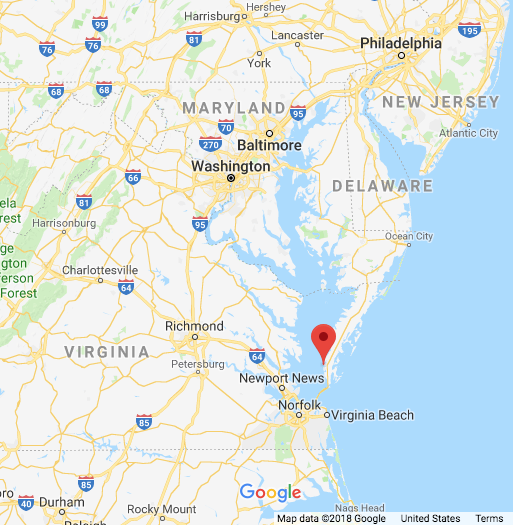The railroad, which had shuttered in 2018, seeks to formally abandon its remaining route miles on the Delmarva Peninsula and the car float operation across Chesapeake Bay.
The railroad filed an abandonment petition with the Surface Transportation Board June 13 to abandon the railroad’s lines between milepost 45.7 at Hallwood, Va., and milepost 94.8 at Cape Charles, Va. The railroad also asks the STB to allow it to discontinue the car float operation between Cape Charles and Little Creek, Va. — across Chesapeake Bay.
The former Pennsylvania Railroad route has been operated by short lines in recent years, including Bay Coast and the relatively new Delmarva Central Railroad, which took over operations on 15 miles of the Bay Coast in 2018.
John Heffner, a Washington-based transportation attorney, told Trains in 2018 that Canonie Atlantic Co., the rail line’s owner, had reached an agreement with Delmarva Central to operate the rail line between Pocomoke City, Md., and Hallwood. There are no customers south of Hallwood — an explicit reason for Bay Coast’s abandonment application. Car float operations ceased around 2012.
Bay Coast also had customers in the Norfolk–Virginia Beach, Va., area.
The railroad is owned by the Accomack-Northampton County Transportation District, a branch of the counties’ governments. It administered the line through wholly owned Canonie Atlantic Co.
Canonie Atlantic operated the line as the Eastern Shore Railroad, then in 2006 leased it to Cassatt Management, doing business as the Bay Coast Railroad. Heffner says Cassatt Management’s owner expressed a desire to leave the business, which brought about the change in rail service.
According to the transportation district’s records, Bay Coast did most of its business on the Norfolk side of Chesapeake Bay. In March 2018, the railroad moved a total of 102 carloads. In February 2018, the railroad moved 133 carloads.















I grew up in Milwaukee and was raised riding the cross lake ferries of Chessie and Ann Arbor, and an enthusiastic observer of the Grand Trunk ferries. I traveled regularly to Norfolk for years, and was thrilled to fly over the car float some years ago and realize that historic vestige was still around. I hope they rail bank the trackage. Losing the rights of way is really a serious problem.
Charles:
Nice remembrance regarding the Detroit river/Great Lake’s parade of RR commerce. Certainly missed, but not forgotten – yet. Thanks for the memory.
ROBERT – Oh yes the 1970’s. When Michigan rail advocates fought hard to save the Chief Wawatam, the well hidden railcar ferry linking the two peninsulas. The carferry is long gone, both Michigan peninsulas are still there, and not one Michigander in a thousand could tell you that this obscure ferry ever ran.
I could be wrong but I believe none of the rails to the ferry terminals in either mitten are still in place. There is little left of the rail lines in northern Lower Michigan or just about anywhere in the UP.
This was only one of the several railcar ferries on the Great Lakes – they’re all gone. Wisconsin, Michigan, Ohio and Ontario are still there. One ferry (formerly of the Chessie) still crosses Lake Michigan but only for highway vehicles, not railcars.
CHRIS – Yes it’s sad. No one is gloating. Life moves on. The economy changes. If the Edmund Fitzgerald (one beautiful laker) hadn’t sunk she would have ended up as a rusted hulk in some marine scrapyard. Shipping on the Lakes is depressed compared to the 1970’s. Leaving the laker fans of our generation (equally as enthusiastic as the rail fans) without their boats. The days when you could stand (except winter) on the Detroit riverfront and watch the parade of the big boats – those days have come and gone.
Back in the early 70’s when a ship rammed the railroad bridge over the C&D Canal, the only way to get rail traffic to the Eastern Shore was via the carfloat at Cape Charles. If a similar incident were to happen now, the Eastern Shore would be isolated from exchange with the national network.
This line was one of USRA’s major preservation projects back in the 1970s. The ghosts of Dr. Pete Patton and several other academics who advocated for the route’s preservation will not be happy at this turn of events.
The Norfolk side has been taken over by the Buckingham Branch Railroad, and will operate as it did before. As for the Eastern Shore Railroad Museum at Parksley, they will be completely isolated. I heard that they were getting some track to run excursions on, but I don’t think it’s confirmed.
Sad
After Ford’s Norfolk Assembly Plant shut down and stopped shipping F-150’s on bilevel racks, the need for the car ferry dropped immensely. The NE Corridor had clearance issues with the racks, so up the Delmarva they went. The CSX-CR-NS recombination removed another reason for the floats, since NS now had alternate routes for through traffic.
Roger Cole: The 1970’s were almost 50 years ago. It makes no sense to keep this operation going via subsidies for a once in 50 years event. If that was to happen again they would just truck the freight across the gap until the bridge was repaired. If it ever was repaired.